Otoplasty in Tunisia
Otoplasty is cosmetic surgery procedure that corrects protruding ears. This defect of disharmony in the head is among the most frequent at this level. Among the causes of this unattractiveness, the most widely held, is the genetic defect that creates a deformation affecting the general appearance of the face shape and giving an undesirable appearance.
The otoplasty, a face cosmetic surgery, which acts on the ear cartilage by changing its shape, in order to get the ears to their natural place with a fairly harmonious shape to the face. The otoplasty in Tunisia is made on a schedule and a preset program in advance to permanently repair this unsightly shape of protruding ears and give the face its harmonious and balanced appearance.
For your surgery, Dr. Chiraz Bouzguenda, a qualified cosmetic surgeon, provides you a detailed study of your case and conduct a full pre operative assessment in order to guide you towards the best solution for your situation. While recovering after surgery, Dr. Bouzguendra will follow up your case to ensure that the result is moving in the right direction. You can contact her for more information and for answers about your otoplasty in Tunisia.
Protruding ears are a minor and frequent, unilateral or bilateral and often asymmetrical malformation.
The protruding ear is an inherited malformation of the external ear, touching his cartilaginous skeleton, but without any impairment of hearing.
It is considered a protruding ear when the pinna is off by more than 30 ° or when the distance between its edge (helix) and the head is greater than 20 or 22 mm.
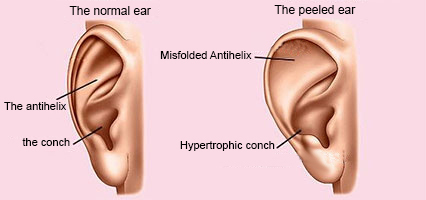
Both in children and adults, protruding ears can cause psychological discomfort and complex.
There are two types of abnormalities that are often more or less related to one another causing a valgus helix: a defect of antihelical fold and hypertrophy of the concha.

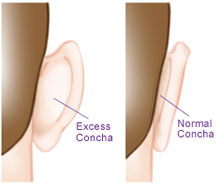
It is necessary to perform cosmetic surgery to correct protruding ears. Named "otoplasty", this intervention aims to change the form of the pavilions that are excessively visible and protruding.
In a more general way, this procedure is performed on both ears, but in some cases, it can be done unilaterally.
Otoplasty is an operation that corrects the cartilage problems that are in the area of the earflap and causes the appearance of a flat ear. In terms of mapping, we can distinguish three different kinds of defects that associate them:
- The real "separation" is performed by an angle rather accentuated between the pinna and the skull (Helix valgus).
- The protruding aspect is supported by the relatively increased size of the cartilage of the ear conch, projecting forward (hypertrophy of the concha).
- It looks too smooth, like the pinna"stretched", which generates a defect of the normal cartilage (default plication antihelical).
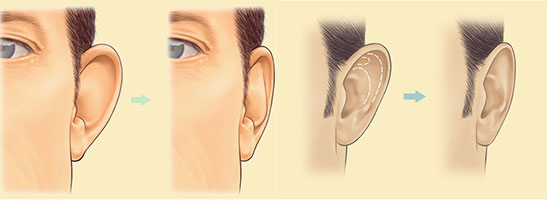
To correct these defects permanently, this Otoplasty surgery, acts on the cartilage to reshape it, allowing "re-sticking" the ears, making them symmetrical and in a harmonious sizes. This also helps in reducing the psychological discomfort and school conflicts, at the time when the problem, is corrected it will end the teasing and annoying remarks generated by this appearance.
About 85-90 % of the growth of the ear is completed at the age of 5-6 years.
Surgical treatment may be considered from the age of 7 years (preschool) for psychological reasons.
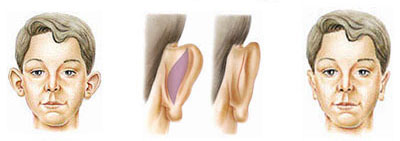
The otoplasty is carried out on adults or adolescents. However, in most cases, the correction of prominent ears surgery is considered since childhood as it is possible from the age of seven when the child so desires.
Dr. Bouzguenda, require a full assessment before the otoplasty surgery, which will comply with the requirement.
It is advised to stop taking aspirin based drugs to a minimum on the 10th day after the Ototplasty surgery.
Thorough washing of the head and hair will be done the day before and the day of surgery.
- Type of anesthesia
The surgical intervention of protruding ears is usually performed under local anesthesia and can be performed under general anesthesia. - Terms of hospitalization
Usually the patient will be hospitalized in “ambulatory”: in a day hospitalization. In addition, it will be possible to leave the same day, by an authorized leave, allowed after several hours of surveillance.
However, in some cases, a short hospital stay at the cosmetic surgery clinic may be recommended. So, for some patients it will be indicated for them to stay hospitalized overnight following the surgery.
The technique of surgery varies from one surgeon to another. Each adopts its own technique and adapts to the case of the patient in order to gain the best possible results. Nevertheless, some basic principles are common to all the techniques:
- Skin incisions :Usually, the incisions are found only at the post-auricular groove, so in the natural crease that is behind either the ear or the other side (rear) of the ear. Sometimes, depending on the case, the surgeon performs small complementary incisions at the front of the pavilion. These latter are placed in natural folds.
- Dissection :
The surgeon then takes off the skin following what is necessary for the case to access the cartilage, and behind the ear. - Cartilage remodeling :
This re-creation or improvement of natural landforms and refinement by folding, it will then be maintained by very fine and deep incisions. At the end, the surgeon brings the pavilion to its proper position so that it is in harmony with the skull while fixing it by deep points. - Suture :
The stitches used by the surgeon are absorbable.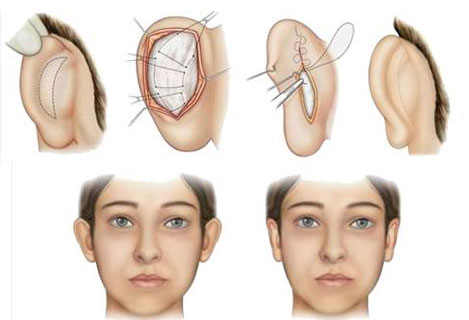
Surgery of Protruding ears in Tunisia - Dressing :
Elastic bands rotate around the head having the role of maintaining the ears in the proper position.
The length of the otoplasty surgery is from 1:00 to 1:30.
Surgery for protruding ears is the price of a scar, that scar is however hidden in the natural crease behind the ear, retroauricular groove; it is very discreet and not visible
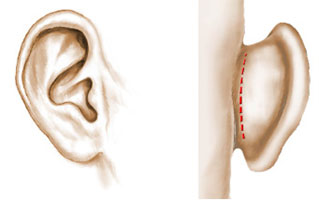
- After surgery, the patient would put a bandage as a helmet to keep the ears in their proper positions for 24 hours after the operation. After expiry of these 24, the medical team will remove the dressing and replace it with another that is lighter which a headband maintains it. At that time, the patient can use his glasses if he has.
- The patient is required to wear a headband to hold and protect the operated areas (type "tennis headband") and keep it day and night for at least 4 weeks after surgery. Throughout this period, the patient should avoid all physical activity or sport.
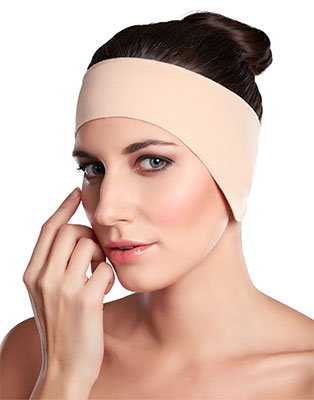
- The patient can use the shampoo in the second day after surgery.
- The sutures’ stitches used will spontaneously disappear.
- As is the case for almost all surgical procedures, the first weeks and months after the same operation have more or less similar sequels:
- During the first week for about 15 to 21 days after the operation, the patient will have swelling (edema) and bruises (blues) at ear level.
- For several months, the patient will lose completely or partially, sensitivity of the pavilion and the earlobe. This requires taking account of the systematic protection of the ears, for at least the first 6 months following the intervention, against the cold (winter hat) and against heat, (hair dryer can be the source).
- The patient may feel some moderate pain which can be relieved by the administration of simple analgesics.
- The patient can see the result of the intervention from the day following the operation and will recognize the gluing ears. However, he can see the final result after 6 months in well defined different ear folds.
The results of otoplasty are very rewarding and give great satisfaction to the patients, by ending their complex and psychological suffering. It helps restore the ears, in resculpting the cartilage and its relief and kink, their symmetry, normal anatomy and harmony with the rest of the face. The result is more definitive.
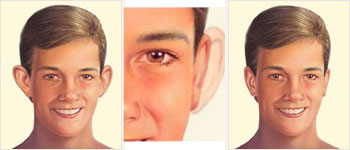
Few are the complications of otoplasty surgery, fortunately for those with protruding ears. This procedure usually has the satisfaction from the final result the majority of patients has. However, there are some complications that are unpredictable and may occur even when the surgeon have all the skill required for the plastic, reconstructive and aesthetic surgery.
Among the complications, some are related to anesthesia, others are caused by a hematoma that will need to be evacuated by surgery.
With drastic surgical aseptic technique, infection, although considered very rare to occur, requires, when it occurs, quick and vigorous treatment to prevent it from reaching the cartilage (chondrite).
Also among the risks, skin necrosis can be caused by disorders on the thin skin at the front area of the earflap, next to a cartilaginous terrain. Local dressings help healing.
Another risk will be to have an abnormality in scars, because despite the very carefully placed by the surgeon sutures, they can cause inflammation in the posterior aspect of the pavilion, a troublesome hypertrophy or even an evolution "keloid (permanent scar hypertrophy). The occurrence of these is unpredictable and difficult to treat. The surgeon will prevent these risks by compression prescription, and silicone gel application.
Finally, we must not overestimate the risks of otoplasty but just to know that even simple surgery, can sometimes meet complications.
Ear surgery abroad
- Procedure :This is a cartilage correction that arise at the pinna and that cause an off appearance.
- Anesthesia: Local or general potentiated
- Operating time: 1 hour to 1 hour 1/2 hour
- Length of stay: In outpatient or 1 night
- Length of the overall stay : 7 days
- Recovery:7 to 10 days
